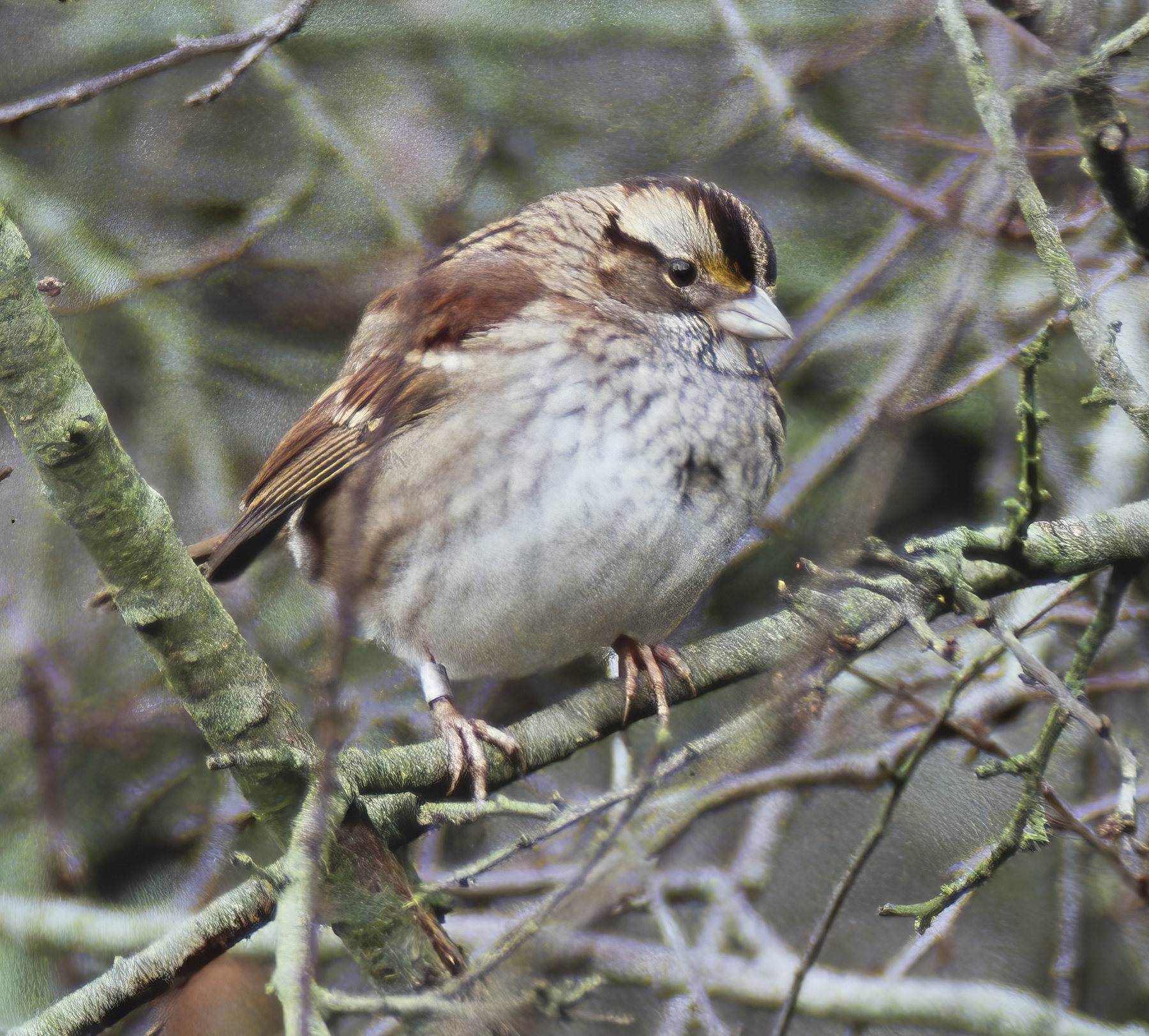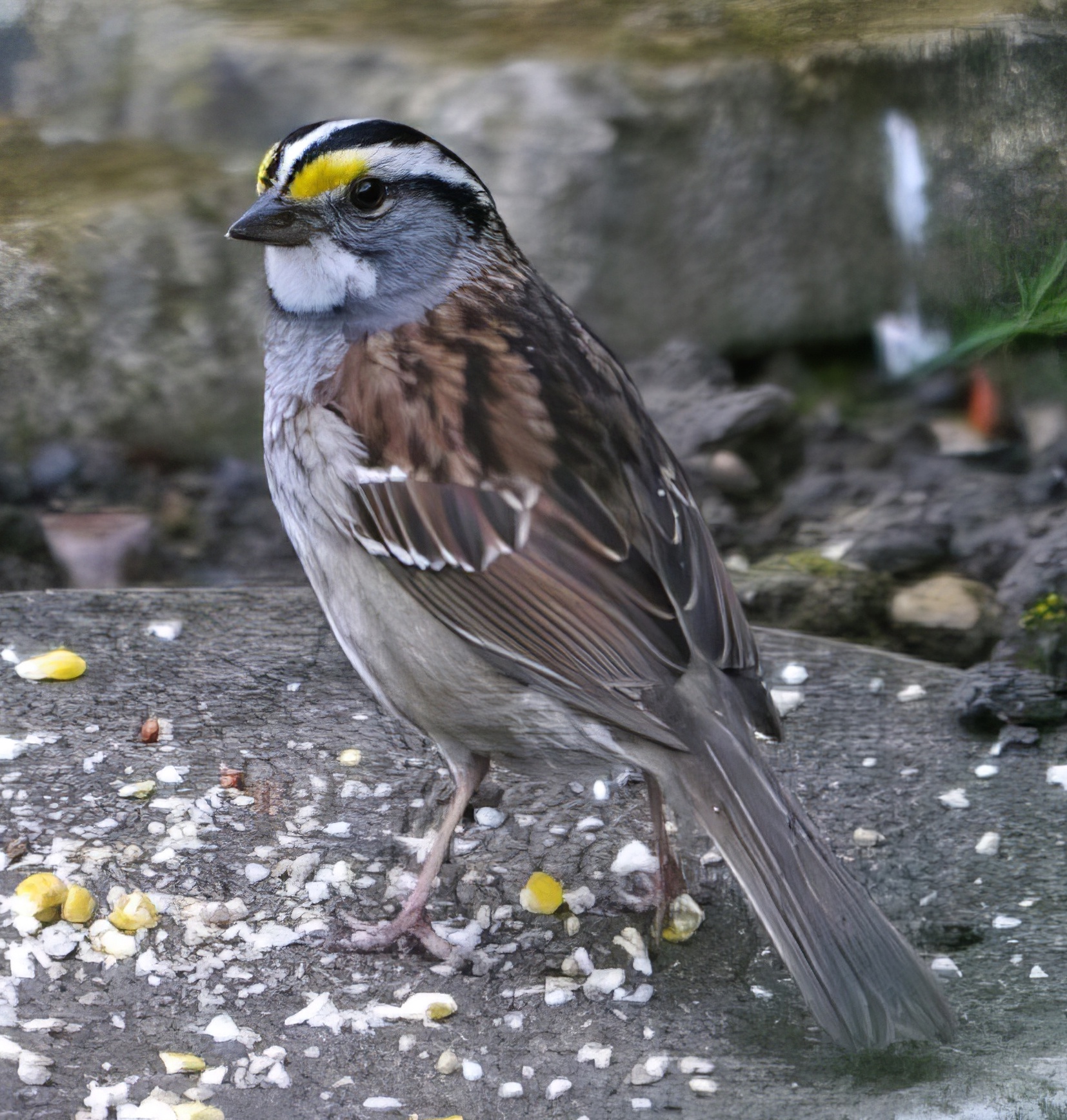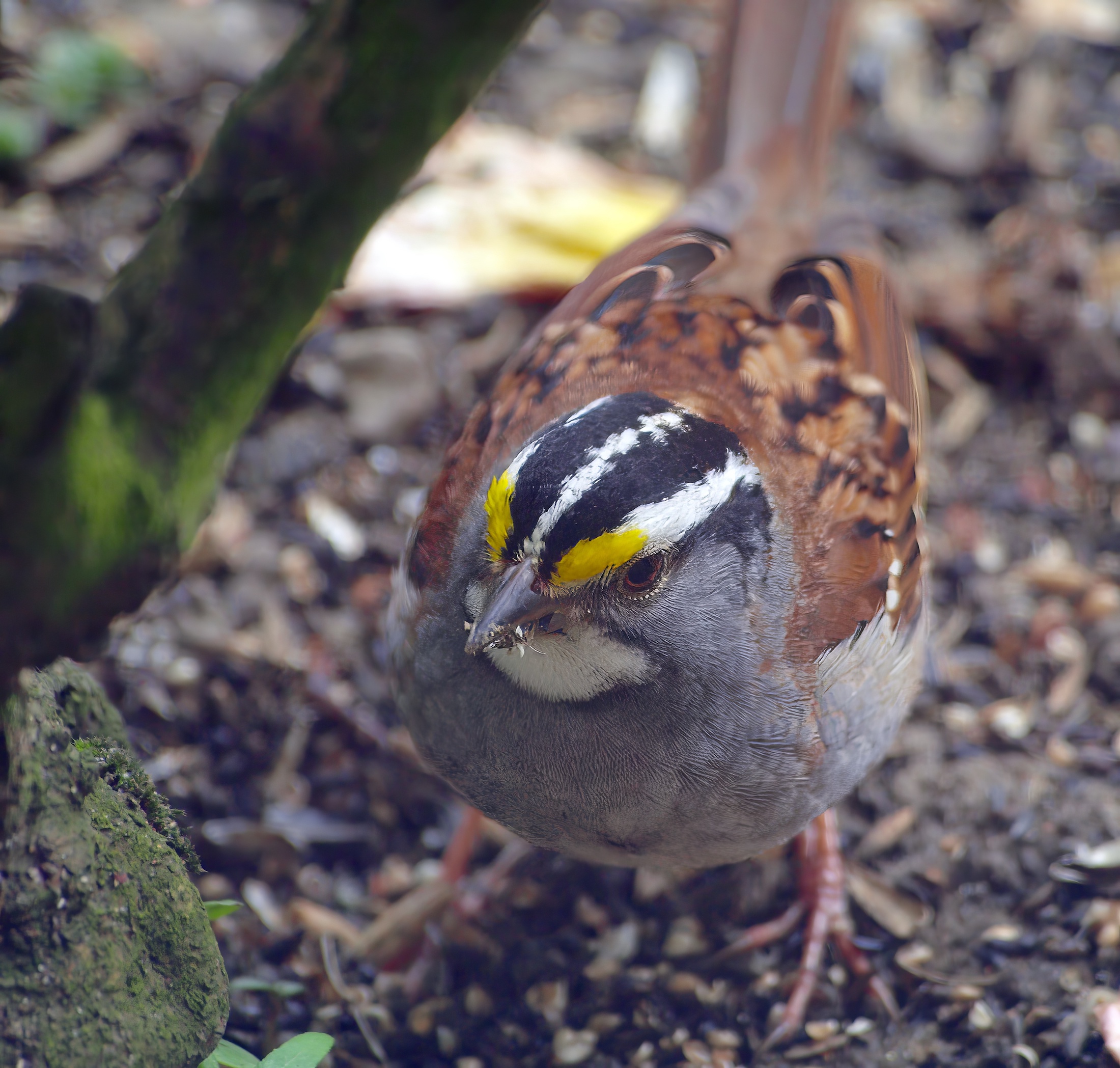White-throated Sparrow Zonotrichia albicollis
Vagrant. North America.


White-throated Sparrows: left, Willingham Woods December 6th 1992 (Graham Catley); centre, Fulbeck June 18th 2010 (Dick High);
right, Spalding May 28th 2013 (Steve Lyon).
Another species in the line of unexpected North American vagrants with three county records, the first in December 1992-March 1993; the second June 2010 and the third May 2013. The first of these was caught in Willingham Forest by a group of disbelieving ringers (see Finder's Report, below) who were trapping in a very weedy field which had attracted a large number of finches. It settled into the area staying until March 1993 during which time it was enjoyed by several hundred observers. It is assumed that this bird turned up in the previous autumn and remained unseen until its appearance in a mist net. There are two further records in June 2010 (when there were seven in Britain) and May 2013 (two in Britain), both of them turning up in suburban gardens.
There have been 53 records in Britain to 2021 averaging about one a year. The arrival of North American Sparrows has been widely discussed in the literature and inevitably ship assistance is suspected as the majority has turned up near shipping routes and White-throated Sparrow is one of the commonest species to be seen on ships at sea. What of the Lincolnshire records? There are port locations not far away to both the north and the south of the county. Lees and Gilroy discussed the issue in Slack (2009) and noted that spring vagrancy in North American passerines is rarer and less predictable than in autumn when sparrows predominate. In addition, spring weather conditions in the Atlantic do not promote vagrancy and granivorous species may stay on deck for longer and survive better. Whether the Lincolnshire birds have arrived in autumn and survived over-winter or have moved onward after a ship-assisted arrival is a moot point, but they are always welcome - unlike many other Nearctic passerines, the sparrows do tend to appear near shipping routes (Hudson et al. 2011) and, while most have been on the west coast or the northern isles, around a quarter of British records have been along the east coast or on North Sea platforms.
| Site | First date | Last date | Count | Notes |
| Willingham Woods | 05/12/1992 | 28/03/1993 | 1 | 1CY, trapped and ringed |
| Fulbeck | 18/06/2010 | 19/06/2010 | 1 | Coming to a garden feeding station |
| Spalding | 28/05/2013 | 29/05/2013 | 1 | Coming to a garden feeding station |
Finder’s report: White-throated Sparrow at Willingham Woods, December 5th, 1992, first county record
by Mid-Lincs Ringing Group, with notes by G. P. Catley.
Note: this account is based on the account which appeared in the Lincolnshire Bird Report 1992, and with reference to the original BBRC submission. There was one other record in 1992, in Suffolk, which was remarkably close to Felixstowe docks. These were the first records since 1989 and the 18th and 19th for Britain and Ireland. The dates of the Suffolk bird coincide with those of ten previous spring records. This one in Lincolnshire, which survived some extremely cold winter nights, is the 3rd to overwinter.
Circumstances
Situated in what is primarily coniferous woodland, Chapel Hill Farm includes a small field of about two acres. This is sown annually with kale and beans for Pheasant cover and there is a large amount of Fat Hen, Chenopodium album, and Dock, Rumex sp. These weed seeds have proved to be a magnet for large numbers of finches and the site has been regularly mist-netted in the winter by the Mild-Lincs Ringing Group (MLG) for the past 10 years. The field is surrounded on two sides by old thorn hedges and bushes used as roosts.
At 08.00hr. on Saturday, December 5th, five members of the MLG erected about 300 ft. of mist-net in and around the field. Several Lesser Redpoll, Carduelis flammea cabaret, were netted during the morning. At 09.45 hr. Nigel Bray extracted a sparrow-like passerine which could not be immediately identified by the observers present. With the aid of suitable North American field guides it was quickly identified as a White-throated Sparrow, Zonotrichia albicollis. In view of its status other MLG members and the County Recorder were contacted and attended shortly afterwards. Graham Catley confirmed the identification from experience with the species in Canada.
The weather was bright and sunny with a light SW wind, 10% cloud cover and no rain; the earlier part of the week had been dominated by strong SW wind. After ringing, processing and being photographed, the bird was released at 10.45 hr. and promptly settled in a nearby Alder, calling loudly for several minutes before flying off. It was seen by about 30 observers the same afternoon, and by several hundred the following day.
Description
General – bunting-like bird with stout conical bill, relatively long tail, plain rump, and striking head, back and underpart patterning.
Head – lores and fore-supercilium a pale lemon yellow and very obvious and bright in the hand but invisible in the field from 50m range even with a 30x telescope, but more visible later in its stay in sunlight at close range. Supercilia narrow over eye then broadened to a wide, deep patch at the rear and all a pale buff with fine darker streaking visible in the hand. Dark lateral crown stripes began adjacent to centre of base of upper mandible and curved over supercilia to rear crown and towards nape sides, mostly blackish but with odd rich rufous feather tips in amongst the black. Median crown stripe again pale buff and narrow but reaching from culmen to rear crown, best seen in the field when bird perched head-on. Dark, blackish eye-stripe from rear of eye underlined the pale supercilia and curved down slightly at the rear round on to rear upper edge of ear coverts. A thin and unobvious blackish moustachial streak from below eye down to bottom front corner of ear coverts, which were a uniform grey with a slight buff tinge when seen in the hand. Sub-moustachial stripe creamy, separated from white chin/throat by a narrow broken grey-black malar streak which ended at the lower throat.
Upperparts – nape grey-buff with fine dark streaking; back/mantle ruddy brown with lines of heavy black streaking which ended level with upper tertial where lower back and rump were a pale, almost ochre-tinged, buffy-brown, and unmarked. Tail a neutral mid-brown on upper side but pale under; in the hand outer two tail feathers showed a slightly paler creamy distal third to outer web.
Underparts – chin-throat clear white; upper breast washed grey with fine darker streaking forming a gorget; grey streaking then continued on to breast sides; lower breast and belly white; flanks washed buffy grey-brown and marked with thin, darker brown streaks; undertail coverts pale buffy; fine dark streaks along sides of vent and undertail coverts.
Wings – lesser coverts and scapulars mostly rich, ruddy brown with black central streak to all scapulars, forming obvious rich colour at bend of wing. Median coverts black with distal third clean white forming obvious wing-bar in the field. Greater coverts black centred with rusty fringes and whitish tips, forming clear cut white, but broken, wing-bar caused by thin shaft streak extending to tip of each feather. Tertials similarly black-centred with clear-cut rufous edges fading to whitish tip; again, black of feather centre extended right to tip of feather and broke the paler buff-rufous fringe. Secondaries brown with buffy outer webs; greater primary coverts rich brown. Primaries dark brown, outer webs paler. Whole effect on closed wing was of a rich chestnut/rufous forewing patch and wing panel, obvious thin white wing bars and uniform, paler edged flight feathers. Lemon yellow feathers on underwing at bend of wing, only seen in the hand.
Bare parts – bill was stout and conical, pointed, and dull horn colour with slightly darker culmen and cutting edge. Eye pupil black and iris a typical “1CY Dunnock” brown, i.e., a slightly ruddy mid-brown. Legs and feet dull flesh.
Voice – call given on release four times was a metallic “chink-tchink”, loud and clear. During several visits over the next three months GPC also noted other calls namely a loud, hard “chink”, a high-pitched “seep”, a quieter “sip”, “seep”, “tsit” and an upward inflected “tseee-eeet”. At least one call was likened to turning a cork in the neck of a bottle.
Biometrics
Tarsus width was measured, and it was found that a BTO 2.8mm (size B) fitted best, and this was placed on the right tarsus. S. A. Britton and J. R. Mawer took the following measurements:
Wing length 74 mm.
Emargination to 3rd, 4th, 5th, and 6th primaries; depth of emargination on 3rd primary was 26 mm; wing point = 5th primary.
Hind claw length 7 mm; tarsus 26 mm; weight 24.6 g.
Bill: length to feathering 9 mm; depth 8 mm; width 6.2 mm.
Tail length 71 mm.
Those present during the ringing process were S. A. Britton; J. R. Mawer; N. Bray; D. Cullum; P. G. Chapman; S. Carter; G. P. Catley.
Addendum
The bird was seen by more than 500 observers the next day and was still at the site feeding on the ground in the weedy field and occasionally flying up into the surrounding bushes. From December 8th was spending more time loafing and feeding in a brash pile and associating loosely with 1-2 Dunnocks and calling more regularly from December 7th onwards, which may suggest it was fairly newly arrived when caught.
Later in its stay it developed a pattern of feeding on grain and seeds put down by the side of its favoured Hawthorn/Blackthorn hedge and reverting to the depths of the hedge to rest and digest. It was also regularly seen scratching in the leaf litter, rather in the manner of a chicken, both feet together, and eating the odd invertebrate. It associated loosely with the 3-4 Dunnocks present in the same area and became aggressive towards them occasionally, and also to Chaffinches which at times ventured too close. It could easily be located by the thin, high-pitched, shrill call, usually given singly, but heard on at least one occasion on December 23rd to be tripled when aggressively attacking a Chaffinch.
Reference
High, D. (undated) White-throated Sparrow Zonotrichia albicollis in Fulbeck. Lincolnshire Bird Report 2010 p.175.
Hudson, N. and the Rarities Committee (2011) Report on rare birds in Great Britain in 2010. British Birds 104: 557-629.
Mid-Lincs Ringing Group and Catley, G.P. (undated) White-throated Sparrow at Willingham Woods December 5th-late March 1993. Lincolnshire Bird Report 1992 pp.88-90.
(Account prepared December 2017; updated with reference to the new Birds of Lincolnshire (2021) January 2023)


